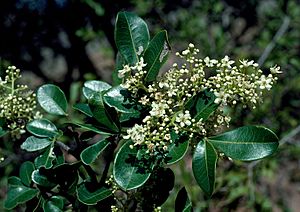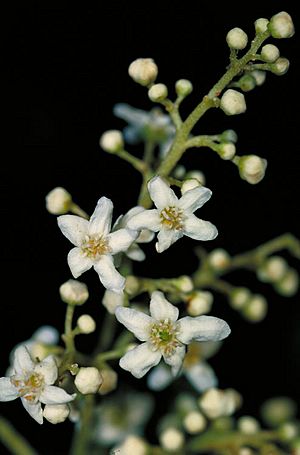Broad-leaved leopard tree facts for kids
Quick facts for kids Broad-leaved leopard tree |
|
|---|---|
 |
|
| At Nuga Nuga National Park | |
| Scientific classification | |
| Genus: |
Flindersia
|
| Species: |
collina
|
| Synonyms | |
|
|
The Broad-leaved leopard tree (scientific name: Flindersia collina) is a cool tree from the Rutaceae family. This family also includes citrus fruits like oranges! It's found only in north-eastern Australia. People also call it the leopard ash or leatherwood. This tree often has leaves made up of smaller leaflets, usually three to seven of them. It also grows pretty white flowers in clusters and unique fruits with rough bumps.
Contents
About the Broad-leaved Leopard Tree
The Broad-leaved leopard tree is a tall tree. It can grow up to 40 meters (about 130 feet) high. That's as tall as a 10-story building! Its bark peels off in oval pieces. This leaves shallow marks on the trunk.
Leaves and Flowers
The leaves of this tree usually grow in pairs. Each leaf is made of three to seven smaller leaflets. These leaflets are shaped like an oval or an egg. They are about 25 to 90 millimeters long. That's roughly the length of your thumb! They are also 10 to 47 millimeters wide. Sometimes, the tree has simple leaves instead. These are similar in shape but grow on a short stem.
The flowers grow in groups called panicles. These clusters can be 30 to 180 millimeters long. Some flowers are male-only. The flowers themselves are small, about 5 to 8 millimeters wide. They have tiny sepals and white petals. The petals are about 4 to 5 millimeters long. You can see these flowers almost all year. But they bloom mostly in spring.
Fruits and Seeds
After flowering, the tree grows a woody fruit. This fruit is called a capsule. It is 25 to 50 millimeters long. Inside the capsule are winged seeds. These seeds are 14 to 25 millimeters long. The wings help the seeds fly away in the wind.
Tree's History and Name
The Broad-leaved leopard tree got its official name in 1898. A scientist named Frederick Manson Bailey described it. He wrote about it in the Queensland Agricultural Journal.
Where the Tree Grows
This tree loves to grow in rainforests. It also lives in dry scrub areas. You can find it from near the sea up to 700 meters high. That's about 2,300 feet! It grows in northern Queensland. It also reaches down to north-eastern New South Wales. You can spot it in places like Lakefield National Park. It's also found in Toonumbar National Park.
How We Protect It
The Queensland Government keeps an eye on this tree. They classify it as "least concern." This means it's not currently in danger. This status is under the Nature Conservation Act 1992.


